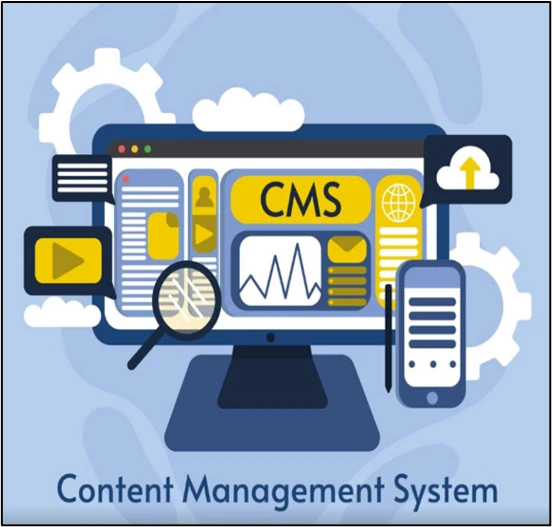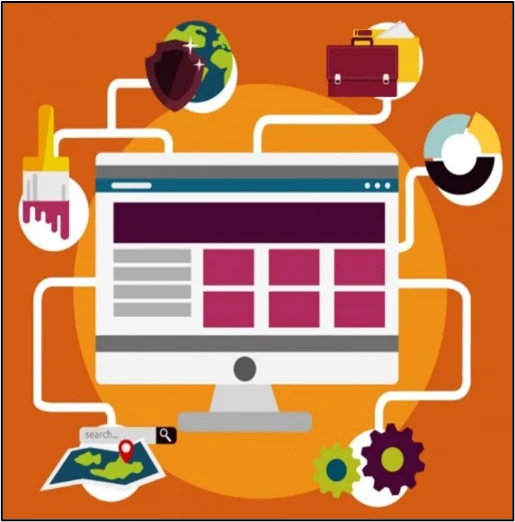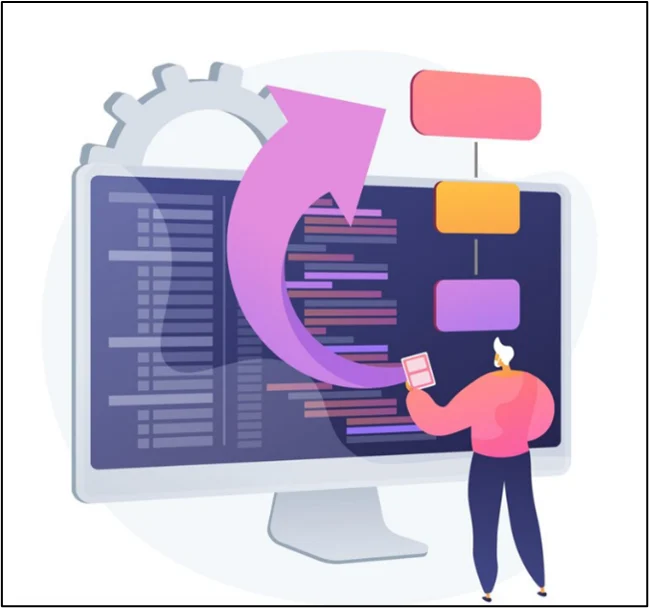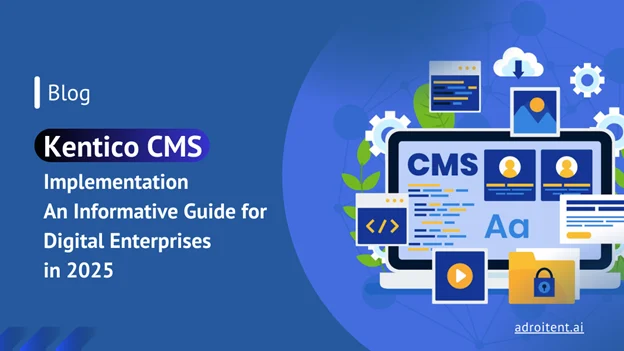Table of Contents
What is a Content Management System (CMS)?
What is the Importance of Kentico CMS for Digital Enterprises?
Digital Experience benefits with Kentico CMS include
What are the latest versions of Kentico for Businesses to Know?
What are the 6 Phases involved in Kentico CMS Implementation?
What are the Best Practices for Kentico Implementation?
3 Critical Kentico CMS implementation challenges
Why choose Adroitent for your Kentico CMS Implementation?
Adroitent’s Content Management Services –Kentico CMS
What is a Content Management System (CMS)?

A content management system (CMS) is a software that helps users to create, manage, and modify digital content. Users can create, edit, and organize their content along with publishing the same content from the dashboard. The CMS helps users customize the interface to their needs and assign privileges to different roles. The various types of CMS include Open Source, Proprietary, and Software as a Service (SaaS) CMS including cloud-based solutions. This CMS software helps to modify content and upload without the need for any coding or technical knowledge.
CMS Features Overview and Major CMS Platforms
Some of the most important features of CMS include intuitive indexing, quick search and indexing, seamless format management of HTM and PDF documents, and publishing content using templates.
Some of the most common CMS platforms
WordPress: This is an open-source CMS that is widely used by many organizations. It is highly customizable with both paid and free themes and plugins available.
Drupal: This CMS is designed for large organizations and offers a large library of modules and themes to choose from. It is easy to customize and deploy and can handle large volumes of data.
Joomla: This is an open-source web CMS and is built on a model-view-controller framework. It is written in PHP and has many features such as caching, RSS feeds, blog posts, search, and support for language translation.
Sitecore: It is a widely used Web CMS globally. Some of its features include personalization, marketing automation and E-commerce sites. Sitecore is best used to improve businesses’ online presence and improve engagement and conversion rates.
Kentico: Kentico is also a Web CMS and a digital experience platform (DXP) that enables organizations to build, customize, and manage websites, online stores, and various other digital applications.
This blog article focuses on various aspects of Kentico and why its implementation will matter a lot to digital enterprises in 2025.
What is the Importance of Kentico CMS for Digital Enterprises?
In recent times, the Kentico CMS platform has gained a lot of importance for enterprises, as it has powerful features and is best defined as a digital experience platform (DXP). It is an ASP.Net-based CMS best suited for mid-sized to enterprise-level businesses.

Kentico CMS innovative features
Some of its major features include Drag and drop page builder helps with quick content creation, quick and easy Multi-site management, E-commerce capabilities for building online stores, personalized shopping experiences, seamless payment gateway integrations, and AI-powered content recommendations.
The other features include:
Effective digital experience platform (DXP): DXP has been named as enabling the best digital experience platform and provides personalized content delivery and supports A/B testing, email marketing, and marketing campaigns.
- Easy-to-use interface: Kentico CMS is defined as a robust CMS with an easy-to-use drag-and-drop interface.
- Enterprise-level security: It delivers robust security features with enterprise-level security delivering peace of mind to businesses and their customers.
- Scalability & flexibility: Kentico CMS improves scalability, provides more flexibility, and optimizes the performance of websites with effective performance optimization.
- Personalized user experiences: It delivers personalized user experiences based on customer behavior, preferences, and demographics which enhances brands’ online presence.
- Security and Compliance: Supports GDPR, HIPAA, and other data privacy regulations.
- Multi-level and multi-lingual: Allows to create and manage content in multiple languages across websites from a single platform.
Digital Experience benefits with Kentico CMS include
- Best CMS for E-commerce and Online Shopping Sites: It is best suited for building,managing, and optimizing websites, especially E-commerce sites, enabling a unified digital experience.
- Personalized experiences: Uses AI-driven personalization to customize experiences based on the user behavior.
- Omnichannel content delivery: Delivers a consistent and engaging user experiences across multiple channels such as websites, mobile apps, email, social media, etc.
- AI-powered marketing automation: Enables quick and easy marketing automation for emails and campaigns.
- Data-driven decisions: Enables data-driven decision-making by leveraging data insights to optimize marketing strategies.
- Brand loyalty: Improves brand loyalty with personalized customer journeys enabling seamless CX.
- Go-to-market: Helps enterprises to go to market faster with streamlined workflows by repurposing content.
What are the latest versions of Kentico for Businesses to Know?
- Xperience by Kentico’s hybrid headless architecture: This architecture enables faster and more flexible implementation, allowing you to start small and build as you evolve. With its rich set of ready-to-go capabilities and APIs
- Kentico Xperience: A complete DXP solution for web content, e-commerce, and marketing.
- Kentico Kontent: A headless CMS for structured content management via APIs.
What are the 6 Phases involved in Kentico CMS Implementation?
The Kentico implementation for a digital enterprise follows a structured six-phase approach to ensure smooth deployment, scalability, and business alignment.
1.Discovery and Planning Phase
- Conduct in-depth business analysis to define the information architecture tailored to organizational needs.
- Prepare Kentico content architecture – Audience Awareness (content managers)
- Perform rendering and component architecture
- Draw designs for information and component architecture
- HTML/CSS architecture
- Back-end code architecture
2. Architecture and Design Phase
- Draw sketches to align with the information architecture
- Adopt which will be further used to build components
- Secure stakeholder approvals and align designs with product roadmaps.
3. Development and Customization Phase
- Monitor HTML/CSS architecture
- Build HTML at a component level
- Create Kentico items
4. Content Migration and Testing Phase
- Migrate existing content from legacy systems to Kentico
- Map content structures and data fields to templates
- Configure Kentico settings, including security, roles, and permissions
- Configure analytics, tracking, and personalization rules
- Conduct comprehensive testing including content editing, workflows
- Conduct multi-layered testing, including functional, regression, UAT, and performance testing to ensure stability and scalability.
- Kentico components made ready for deployment
5. Deployment Phase
- Deploy the Kentico solution to the production environment
- Perform the final testing and validations in the production environment
6. Post-Implementation Support
- Provide support and maintenance for the Kentico environment
- Implement updates, patches, and enhancements as
What are the Best Practices for Kentico Implementation?
Digital businesses should adopt the below best practices in Kentico development to significantly enhance the effectiveness and efficiency of enterprises’ digital experience platform.

- Adopt a proper content tree structure: The content tree should be structured logically to make Kentico implementation easier and more effective.
- Proper metadata management: It should be taken care that the content is properly tagged with metadata to make it effective for search engine optimization. It also helps to manage large amounts of content easily.
- Create reusable content components: It is essential for businesses to adopt and create reusable content components that can be used across multiple pages as this structured creation reduces duplication and makes updates easier.
- Ensure proper performance optimization: Implementing Kentico performance optimization practices ensures your site runs smoothly, even under heavy traffic ad Utilize Kentico’s built-in caching mechanisms to store frequently accessed data.
- Use Content Delivery Network (CDN): In order to reduce latency, use a CDN to distribute your content globally ensuring faster load times for users globally.
- Proper mobile optimization is critical: Ensure that your Kentico site is mobile-friendly which is critical to improve the user experience and search engine rankings.
- Maintain database: Maintain your database by indexing frequently queried columns and cleaning up unnecessary data.
- Implement robust testing strategies: Thorough testing is a critical aspect of Kentico development best practices. It is essential that before deploying any updates or new features, comprehensive testing should be taken up to ensure all features function as expected.
- Adopt robust deployment strategies: It is critical for businesses to adopt robust Kentico deployment strategies to ensure a smooth and error-free transition from development to production. For deployment automation tools such as Azure DevOps and Octopus deploy can be leveraged.
- Follow proper rollback plans: Always have a rollback option in place to quickly revert to a stable state in situations of any downtime.
3 Critical Kentico CMS implementation challenges

- Complex customizations: While Kentico provides a flexible modular architecture, extensive customization (e.g., custom modules, integrations, or headless CMS features) can be complex and time-consuming.
- Content Migration & Data Structuring Complexity: Migrating content from legacy CMS platforms can be challenging, thus requiring structured data mapping and handling inconsistent formats.
- Performance Optimization & Scalability: Large enterprises handling high traffic, global audiences, or complex e-commerce operations may experience performance bottlenecks if Kentico isn’t optimized correctly.
3 Critical Kentico CMS implementation challenges
We offer an effective digital strategy that provides a flexible and scalable Kentico CMS implementations that adapts to evolving needs and technological advancements. Our CMS solutions provide business agility and help businesses thrive in the ever-changing digital landscape.
Adroitent’s Content Management Services –Kentico CMS
Digital Strategy and Consulting | Development and Implementation |
Personalized Brand Experiences | Content Management & Optimization |
Enhancement, Support, and Migration | Setup and Implementation |
Enterprise Integration | Ecommerce Solutions |
Managed Services – Maintenance & Support | Upgradation and Re-hosting |
Some of our strengths for Kentico CMS implementations include:
- An effective team of Kentico implementation experts located in India & USA
- Certified Kentico implementation specialists and architects working across domains
- 7+ years of Mature Kentico practice expertise with an established Kentico CoE
- Extensive hands-on experience in Kentico Xperience, Kentico CMS, Kentico eCommerce, and Kentico Marketing Automation implementation.
- Enterprise-class security practices to keep your data safe.
- 20+ projects delivered to leading Fortune 500 clients located globally
- Thought Leadership with Integrated Agile Delivery Model™ and AgileSourcing™ engagement models
- Ensure quick and easy deployment along with easy integrations with third-party systems
- Adopt a future-proofed digital strategy with flexible and scalable frameworks ensuring faster time-to-market and quicker ROI
- Provide business agility to thrive in the digital landscape
- Cost-effective implementation support services
Connect with our teams to know more.
FAQ'S
What is Kentico CMS?
Kentico CMS is a fully integrated content management system (CMS) and digital experience platform (DXP) that allows businesses to create, manage, and optimize digital content across websites, e-commerce platforms, and customer portals.What are the key features of Kentico CMS?
Kentico CMS offers robust features such as:- Content Management
- Digital Marketing Tools
- e-commerce Integration
- Headless CMS Capabilities
- Customizable Workflows
- Multilingual and Multi-Site Support
- Strong Security and Compliance



